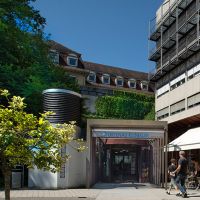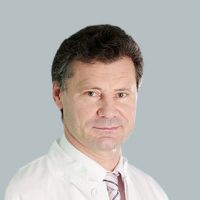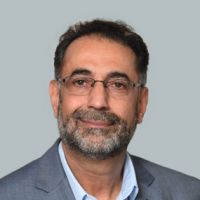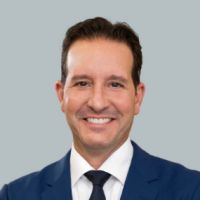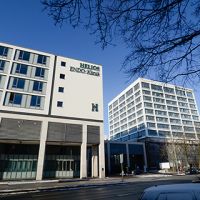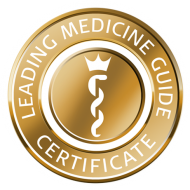Recommended specialists
Article overview
Spinal surgery - Further information
Background information on spinal surgery
Spinal surgery comprises a broad range of different operations that can involve a variety of diseases and injuries.
In the specialized field of spinal surgery, different medical specialities converge. Orthopaedics, neurosurgery and surgery itself.
This is because the spine is a complex anatomical structure in which different structures of the anatomy are joined. Therefore spinal surgery can involve bones, muscles, soft tissue or nerve tissue. In accordance with this, different medical experts are responsible for spinal surgery, by whom, then, the different disease complexes can be treated.
When is spinal surgery necessary?
Many common diseases may lead to the indication of spinal surgery. These may include, for example, herniated disc, spinal cord tumour, fractures of the vertebrae or scoliosis.
While for a herniated disc or spinal cord tumour the neurosurgeon would be the best discipline, a vertebral fracture is in the field of orthopaedics.
Major surgery, such as spinal fusion, in which a large section of the spine is treated, combines several subdisciplines and requires physicians that can treat various different structures. This is because stiffening of the spine affects both the muscle tissue and structures of the skeletal system. Blood vessels and nerve fibres. Of course, such major operations must also be monitored radiologically with an imaging procedure. Only in this way can an optimal result be achieved with spinal surgery.
The examples show that spinal surgery is indicated in many instances. There are both common diseases such as intervertebral disc prolapse as well as rare ones such as multiple vertebral fractures, which require making the spine more rigid.
While this procedure is complicated and multilayered, the fracture of an entire vertebral body, for example caused by osteoporosis, can be corrected by the placement of bone cement. This procedure involves a minimally invasive percutaneous procedure. So-called vertebroplasty or kyphoplasty.
Techniques in spinal surgery
As the examples above show, the operative procedure depends on the clinical picture at the moment. For this reason, in addition to serious invasive procedures, spinal surgery also involves some that can be carried out minimally invasively.
But usually one can say: The more massive and comprehensive the situation, the more complex the operative intervention. Narrowing of the spinal canal due to surrounding structures can be treated, for example, in a percutaneous procedure using the laser. This only requires a small skin incision and hardly damages the surrounding tissue.
But making the spine rigid after multiple spinal fractures involves many discs and a longer section of the spine. In addition, here materials must be brought into the operative field so that the damaged spinal section can be supported. Accordingly, a larger incision is needed, so that more soft tissue is damaged. There is also the danger that both nerve pathways and blood vessels may be affected. In an invasive operation of this scale, in addition, more muscles are damaged, so that the overall wound healing can take longer and the scar formation involves certain risks.
Of course an invasive operation also heals more slowly than a minimally invasive one. However, when it comes to spinal surgery it is the diagnosis that has been made that determines the operation. So the spinal surgery expert is dependent when it comes to his operative technique on the disease or injury that is present. Even a specialist in spinal surgery cannot always operate minimally invasively.
Spinal surgery
Because the spine is a complex system comprised of different anatomic structures, on an operation on the spine many factors must be considered. It is irrelevant whether what is concerned is a major or minimally invasive operation.
Within a small space, in the spine there are both important blood vessels and spinal nerves and the spinal cord. All the nerve fibres that allow communication between the peripheral nervous system and the brain in the human body are gathered there. An injury to the spinal cord can have fatal consequences. It can lead to compromised movement, loss of sensitivity, functional disorders of the bladder and intestines, or even paraplegia.
For this reason, during spinal surgery all surrounding structures must be dealt with extremely cautiously, so that no damage occurs either from a minimally invasive procedure or a conservative one.
Post-spinal surgery measures
Of course, on the basis of the different operative techniques the time of healing and regeneration varies, as well as the measures that may need to be taken for rehabilitation.
While after a minimally invasive procedure, for example after a herniated disc, the patient can be fit immediately afterward and continue his daily activities normally, after an invasive procedure such as spondylodesis a long period of regeneration is required that can also include rehabilitative measures.
The more complex the operation, the longer the regeneration time required for wound healing. After all, in a complex operation a significantly greater amount of tissue is damaged. Of course this takes more time to heal. In addition more surrounding tissue is damaged as well, as well as muscle. Not only does the musculature need to heal after an operative intervention involving spinal surgery, but must then be strengthened again in order to be functional once more.
Medical spectrum
Therapies
- Back pain treatment
- Facet infiltration
- Intervertebral disk surgery
- Intervertebral disk surgery to the cervical spinal column
- Kyphoplasty
- Minimal invasive (intervertebral) disk surgery
- Nerve reconstruction
- Neuromodulator
- Neuronavigation
- Neurosurgical pain treatment
- Percutaneous nucleotomy
- Percutaneous spinal surgery
- Spinal correction
- Spinal stabilization
- Spine stabilization surgery using cage
- Spondylodesis
- TLIF (transforaminal lumbar interbody fusion)
Diseases
- Cauda equina syndrome
- Cervical spinal disk herniation
- Childhood nerve cancer
- Flat Back Syndrome (post-op)
- Intervertebral disc degeneration
- ISG syndrome
- Kyphosis
- Lumbar spinal pain
- Meralgia paraesthetica
- Nerve cancer
- Neurofibromatosis
- Osteochondrosis
- Paralyses
- Postnucleotomy syndrome
- Posttraumatic kyphosis
- Spinal canal disorders
- Spinal canal stenosis
- Spinal conditions
- Spinal cord injury
- Spinal cord tumor
- Spinal disk herniation
- Spinal distortion
- Spinal fracture
- Spinal instability
- Spinal tumor
- Spondylitis
- Spondylodiscitis
- Spondylolisthesis
- Spondylopathy
- Spondylosis
- Supinator syndrome
- Tethered cord syndrome
- Thoracic outlet syndrome
- Whiplash injury







